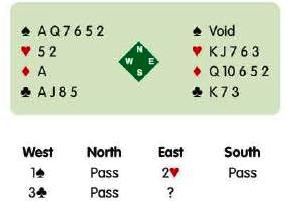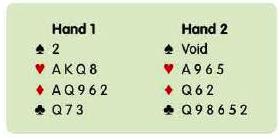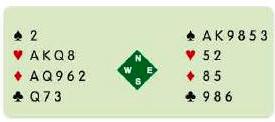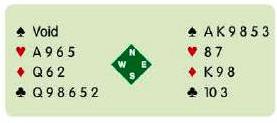Source: Mr Bridge 



Stay low on a misfit probably dates from the earliest years of contract bridge. It is a most useful maxim. By definition, you and your partner do not have a trump fit, so playing in a suit contract is probably not a good idea. The trouble is, you might arrive at an uncomfortably high level before you can figure this out. For example:
East-West have lurched up to t

he three level, are still in a forcing situation and have failed to find a trump fit. As you can see, no game contract looks very appetising on these cards. Unfortunately, the chances are that East-West, having failed to find a fit, will end up in 3NT. Of course, that has its own problems. Suppose the defence lead a club. Where are nine tricks coming from? There are only four tricks on top. You will need a lot of luck to bring the total up to nine. With the void in spades, East might have foreseen the misfit and responded INT. Why does 3NT fare poorly on this sort of deal? There are two reasons. Firstly, no suit is able to act as a source of tricks -not surprising, given the misfit. Secondly, transport between the two hands is often difficult. With misfitting hands, there tend to be few entries from hand to hand. Even if you seem to have plenty of tricks, it may be hard to reach them. If you set up one hand, the defenders put you in the other.
There are usually warning signs during the auction to indicate that the two hands are a misfit. For example: a Partner bids a suit in which you have a void or singleton. b Partner refuses to support your suit even after you have bid it twice.
An opponent makes a bid (or a takeout double) that shows your suits – you deduce that partner must be short.
As soon as you diagnose that the hands do not fit well, my advice is to drop the bidding as soon as possible. The correct auction with these two hands is: 1

-1NT-2

-End.

Here are two more examples: With Hand 1, you open the bidding with 1

. Partner responds 1

, which is not very promising. Still, you have a solid 17 points, so your next move is to make a reverse bid of 2

, which shows both your strength and longer diamonds than hearts. Partner bids 2

(non-forcing).
What do you do now? It is easy to think, ‘my partner has responded, so game cannot be far away. Even if he has only 6 or 7 points, it must be safe to issue an invitation.

Let’s try 2NT: Here, you see a typical hand for partner – indeed, it could be worse. What is poor partner to do now? 2NT will play poorly. You will need the diamond finesse and probably a club trick to get close. That is even ignoring the problems of whether or not to cash the second top spade the one and only time you are in dummy. Partner could put you into 3

or try a desperate 3

but these may fare almost as badly. The root cause of all these problems – both in the bidding and in the play – is that the hands are a misfit. Your best course of action is to stay low and pass 2

. When you hold Hand 2, LHO opens 1

, partner overcalls 1

, and RHO passes. What do you do now? Many players would think, ‘oops, I’d better get us out of this mess: and bid 2

. However, in the modern style, when a new suit after partner’s overcall is encouraging or forcing, partner is likely to continue with 2

. This just takes you out of the frying pan into the fire. The hands for your side could be like this:

The best way to ‘get out of this mess’ is to pass. Partner is unlikely to come to much harm in 1

The opponents might come back into the bidding anyway. If they double 1

, then you might run to 2

and partner can be sure that you are making a rescue bid. To sum up, if your hands appear to be a misfit, you may not be able to find a great contract. Instead of thrashing about trying to find one, while the bidding escalates ever higher, do the sensible thing and drop out of the bidding as quickly as possible. As the maxim says: stay low on a misfit.
 he three level, are still in a forcing situation and have failed to find a trump fit. As you can see, no game contract looks very appetising on these cards. Unfortunately, the chances are that East-West, having failed to find a fit, will end up in 3NT. Of course, that has its own problems. Suppose the defence lead a club. Where are nine tricks coming from? There are only four tricks on top. You will need a lot of luck to bring the total up to nine. With the void in spades, East might have foreseen the misfit and responded INT. Why does 3NT fare poorly on this sort of deal? There are two reasons. Firstly, no suit is able to act as a source of tricks -not surprising, given the misfit. Secondly, transport between the two hands is often difficult. With misfitting hands, there tend to be few entries from hand to hand. Even if you seem to have plenty of tricks, it may be hard to reach them. If you set up one hand, the defenders put you in the other.
There are usually warning signs during the auction to indicate that the two hands are a misfit. For example: a Partner bids a suit in which you have a void or singleton. b Partner refuses to support your suit even after you have bid it twice.
An opponent makes a bid (or a takeout double) that shows your suits – you deduce that partner must be short.
As soon as you diagnose that the hands do not fit well, my advice is to drop the bidding as soon as possible. The correct auction with these two hands is: 1
he three level, are still in a forcing situation and have failed to find a trump fit. As you can see, no game contract looks very appetising on these cards. Unfortunately, the chances are that East-West, having failed to find a fit, will end up in 3NT. Of course, that has its own problems. Suppose the defence lead a club. Where are nine tricks coming from? There are only four tricks on top. You will need a lot of luck to bring the total up to nine. With the void in spades, East might have foreseen the misfit and responded INT. Why does 3NT fare poorly on this sort of deal? There are two reasons. Firstly, no suit is able to act as a source of tricks -not surprising, given the misfit. Secondly, transport between the two hands is often difficult. With misfitting hands, there tend to be few entries from hand to hand. Even if you seem to have plenty of tricks, it may be hard to reach them. If you set up one hand, the defenders put you in the other.
There are usually warning signs during the auction to indicate that the two hands are a misfit. For example: a Partner bids a suit in which you have a void or singleton. b Partner refuses to support your suit even after you have bid it twice.
An opponent makes a bid (or a takeout double) that shows your suits – you deduce that partner must be short.
As soon as you diagnose that the hands do not fit well, my advice is to drop the bidding as soon as possible. The correct auction with these two hands is: 1 Here are two more examples: With Hand 1, you open the bidding with 1
Here are two more examples: With Hand 1, you open the bidding with 1 Let’s try 2NT: Here, you see a typical hand for partner – indeed, it could be worse. What is poor partner to do now? 2NT will play poorly. You will need the diamond finesse and probably a club trick to get close. That is even ignoring the problems of whether or not to cash the second top spade the one and only time you are in dummy. Partner could put you into 3
Let’s try 2NT: Here, you see a typical hand for partner – indeed, it could be worse. What is poor partner to do now? 2NT will play poorly. You will need the diamond finesse and probably a club trick to get close. That is even ignoring the problems of whether or not to cash the second top spade the one and only time you are in dummy. Partner could put you into 3 The best way to ‘get out of this mess’ is to pass. Partner is unlikely to come to much harm in 1
The best way to ‘get out of this mess’ is to pass. Partner is unlikely to come to much harm in 1
























